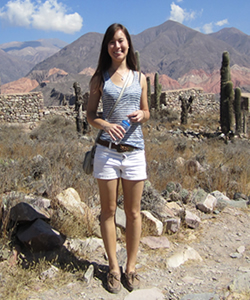
I looked up from my cup of coffee in the café in time to see a group of five in the crosswalk of the street before me. They had the bulky bags, which marked them as students. I continued staring as they meandered across the street and then paused. I imagined them deep in conversation or looking out at something interesting in the distance…until the light turned green.
Cars laid on their horns and squealed around the group to express their rage. Through the window I could see a couple more people join in, but it was only when someone brought a chair did I realize they were not going anywhere anytime soon. By now the cars could not pass, but a stream of motorcycles sneaked around the sparse group of students.
More people, banners, and megaphones rapidly accumulated. Only ambulances were allowed through the blockade, and, to my surprise, the protest held strong even when a bus tried to run them over. It looked peaceful enough, but when the check came, I decided to not push my luck and walked to class in the opposite direction.
After a rich history of protestation, it should come as a no surprise that protests still remain commonplace in Buenos Aires. The series of dictatorships and their repressive regimes, coupled with a crippling economy laced with hyperinflation in the mid-twentieth century, produced a fertile ground for discontent.
Neoliberal reforms, and the political response to the oppressive regimes and their economic failures, seemed to only add to these problems. During the 1990s, under the presidency of Carlos Menem and his neoliberal economic policy, unemployment continued to rise at the same time welfare programs were reduced.
Widespread corruption in the government and within the political parties led to a general distrust in these traditional channels of social representation. Unions, another traditional manner of expression, were only as good as the number of people who held jobs in those sectors. The escalating levels of unemployment therefore weakened their effectiveness.
Together, these factors led to new, unconventional methods of social expression. Piquetes, roadblocks similar to the one I witnessed, grew in popularity, along with cacerolazos, pot-banging assemblies, and escarches, political expressions in graffiti, among others. While some avenues of social and political expression were closed, others were being opened.
Today, I find these new forms of expression engrained in the plazas, on the walls, and in the culture of Buenos Aires. Every space of my history classroom in the University of Buenos Aires is lined with political posters. Occasionally, they are torn down to open the window for a breath of fresh air or to see the professor when they obscure the view.
Plaza de Mayo seems to be the hub of activity. It sits in front of the Casa Rosada, a symbol of the administration in power. Gatherings accumulate on a daily basis, surrounded by several vans of the national press, while signs permanently line the border of the plaza. As explained to me, Argentines often readily celebrate the protests as a symbol of their solidarity. The news channels cover not only the tragedies, like kidnappings and murders, but also the response of their neighbors accumulating in a mass gathering to show support and call for justice.
This is all new to me. My initial reaction to the piqueteros in front of the café elicited thoughts of violence, distrust, and radicalism. Where do these thoughts come from? Are they unique to my upbringing or to my citizenship? History books say that these new forms of social representation in Argentina are a reaction to their inability to express their concerns through other means, like through the government or the political parties.
As Occupy Wall Street gains momentum in the United States, I am left to wonder if we will follow in the footsteps of Argentina. Is this a sign that Americans feel our means of representation in our government are closed off to the common citizen?
About the Author
Opens in a new window
